Aston University, Birmingham (ASTON)
Latest uploads at Aston University, Birmingham (ASTON). Looking for notes at Aston University, Birmingham (ASTON)? We have lots of notes, study guides and study notes available for your school.
-
469
-
4
-
24
Majors at Aston University, Birmingham (ASTON)
Notes available for the following studies at Aston University, Birmingham (ASTON)
-
Aston University, Birmingham 113
-
Economics 1
-
International Business 1
Latest notes & summaries Aston University, Birmingham (ASTON)
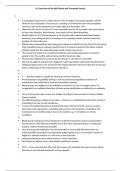
preview:• They are unusual in that the natural occurring antibodies occur in the plasma of subjects who lack the corresponding antigen even if they’ve never been transfused or been pregnant. • The most important of these are anti-A and anti-B, they are usually IgM and react optimally at cold temperatures (4°) although they are reactive at 37° as well. • Immune antibodies develop in response to the introduction of RBCs that possess antigens that a person lacks, and this can occur duri...
- Package deal
- Class notes
- • 7 pages's •
-
Aston University, Birmingham•clinical science
-
clinical sciences BM5CLS• Bysarah21jan
Preview 2 out of 7 pages
preview:• They are unusual in that the natural occurring antibodies occur in the plasma of subjects who lack the corresponding antigen even if they’ve never been transfused or been pregnant. • The most important of these are anti-A and anti-B, they are usually IgM and react optimally at cold temperatures (4°) although they are reactive at 37° as well. • Immune antibodies develop in response to the introduction of RBCs that possess antigens that a person lacks, and this can occur duri...

preview:• People who are living with diabetes generally use a small handheld device to monitor their blood glucose levels daily and therefore that's a form of point of care testing (POCT). • Why we have implemented POCT in some particular areas for some particular tests. • To provide examples and discuss sites where point of care testing plays a key role. • To talk about how we manage it and whether you are obtaining a result within a hospital laboratory on an analyser or whether y...
- Package deal
- Class notes
- • 7 pages's •
-
Aston University, Birmingham•clinical science
-
clinical sciences BM5CLS• Bysarah21jan
Preview 2 out of 7 pages
preview:• People who are living with diabetes generally use a small handheld device to monitor their blood glucose levels daily and therefore that's a form of point of care testing (POCT). • Why we have implemented POCT in some particular areas for some particular tests. • To provide examples and discuss sites where point of care testing plays a key role. • To talk about how we manage it and whether you are obtaining a result within a hospital laboratory on an analyser or whether y...
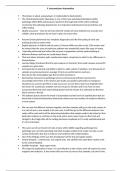
preview:• This lecture is about autoanalysers in relationship to biochemistry. • The clinical biochemistry laboratory is one of the most automated disciplines within pathology within BMS and because it performs the huge bulk of the entire workload received by the pathology department, it is important understand turnaround times and reflex testing. • Quality assurance – how do we know that the results we have obtained are accurate and reliable, what procedures do we have in place to ens...
- Package deal
- Class notes
- • 8 pages's •
-
Aston University, Birmingham•clinical science
-
clinical sciences BM5CLS• Bysarah21jan
Preview 2 out of 8 pages
preview:• This lecture is about autoanalysers in relationship to biochemistry. • The clinical biochemistry laboratory is one of the most automated disciplines within pathology within BMS and because it performs the huge bulk of the entire workload received by the pathology department, it is important understand turnaround times and reflex testing. • Quality assurance – how do we know that the results we have obtained are accurate and reliable, what procedures do we have in place to ens...
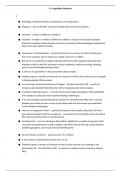
preview:● Glanzmann’s thrombasthenia – autosomal recessive so you have to inherit a faulty gene from mum and dad, and it is quite rare roughly around 1 in a million. ● Because it is an inherited condition patients will present with symptoms following birth therefore earlier in their life and these include nosebleeds, extensive bruising, bleeding gums, excessive bleeding during periods. ● It arises as we get defects in the glycoprotein 2b3a complex. ● Platelets express a number of ...
- Package deal
- Class notes
- • 8 pages's •
-
Aston University, Birmingham•clinical science
-
clinical sciences BM5CLS• Bysarah21jan
Preview 2 out of 8 pages
preview:● Glanzmann’s thrombasthenia – autosomal recessive so you have to inherit a faulty gene from mum and dad, and it is quite rare roughly around 1 in a million. ● Because it is an inherited condition patients will present with symptoms following birth therefore earlier in their life and these include nosebleeds, extensive bruising, bleeding gums, excessive bleeding during periods. ● It arises as we get defects in the glycoprotein 2b3a complex. ● Platelets express a number of ...
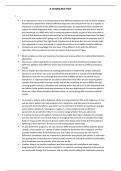
preview:• It is important to have an understanding of the different diseases we look at within medical biochemistry laboratories and the different diagnostic tests we perform but it is equally as important to understand the difference specimen types to understand which samples we require for which diagnostic tests, which samples we can't process and why that is and it's also important as a BMS when you're analysing patient results as part of that to be able to rule out that these results ar...
- Package deal
- Class notes
- • 8 pages's •
-
Aston University, Birmingham•clinical science
-
clinical sciences BM5CLS• Bysarah21jan
Preview 2 out of 8 pages
preview:• It is important to have an understanding of the different diseases we look at within medical biochemistry laboratories and the different diagnostic tests we perform but it is equally as important to understand the difference specimen types to understand which samples we require for which diagnostic tests, which samples we can't process and why that is and it's also important as a BMS when you're analysing patient results as part of that to be able to rule out that these results ar...

preview:• Haemostasis is coagulation. • 1 – of course, we want our blood to clot if we get an injury but why is it important that coagulation is only initiated when we get damage to a vessel wall, why is not a good thing if we were to bleed excessively and not control blood loss and why is it not a good thing if we have this increased tendency to clot spontaneously. • 2 – what are the different factors involved within coagulating or clotting blood, that ranges from platelets to coagu...
- Package deal
- Class notes
- • 6 pages's •
-
Aston University, Birmingham•clinical science
-
clinical sciences BM5CLS• Bysarah21jan
Preview 2 out of 6 pages
preview:• Haemostasis is coagulation. • 1 – of course, we want our blood to clot if we get an injury but why is it important that coagulation is only initiated when we get damage to a vessel wall, why is not a good thing if we were to bleed excessively and not control blood loss and why is it not a good thing if we have this increased tendency to clot spontaneously. • 2 – what are the different factors involved within coagulating or clotting blood, that ranges from platelets to coagu...
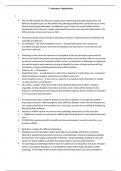
- Package deal
- Class notes
- • 10 pages's •
-
Aston University, Birmingham•clinical science
-
clinical sciences BM5CLS• Bysarah21jan
Preview 2 out of 10 pages
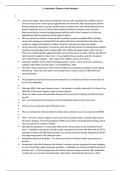
preview:• Levine and stepson discovered a postpartum woman who had delivered a stillborn foetus and an unusual case of intra-group agglutination was observed. She required post-partum blood transfusion and as a group O patient they transfused her with whole blood from her group O husband, she has a severe haematolytic transfusion reaction, and I was later discovered that her serum had agglutinated with the cells of her husband. Her cells also agglutinated with the majority of other type O dono...
- Package deal
- Class notes
- • 5 pages's •
-
Aston University, Birmingham•clinical science
-
clinical sciences BM5CLS• Bysarah21jan
Preview 2 out of 5 pages
preview:• Levine and stepson discovered a postpartum woman who had delivered a stillborn foetus and an unusual case of intra-group agglutination was observed. She required post-partum blood transfusion and as a group O patient they transfused her with whole blood from her group O husband, she has a severe haematolytic transfusion reaction, and I was later discovered that her serum had agglutinated with the cells of her husband. Her cells also agglutinated with the majority of other type O dono...
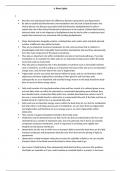
preview• Major biomolecules alongside proteins, carbohydrates and nucleic acids and lipids planned number of different roles within the body. • They are an important structural component to cells, and you know that in relation to phospholipids with their hydrophilic head and their hydrophobic tails and they subsequently form the main component of the plasma membrane. • They play an important role within metabolism and also in hormonal pathways, if we take metabolism as an example free fa...
- Package deal
- Class notes
- • 9 pages's •
-
Aston University, Birmingham•clinical science
-
clinical sciences BM5CLS• Bysarah21jan
Preview 2 out of 9 pages
preview• Major biomolecules alongside proteins, carbohydrates and nucleic acids and lipids planned number of different roles within the body. • They are an important structural component to cells, and you know that in relation to phospholipids with their hydrophilic head and their hydrophobic tails and they subsequently form the main component of the plasma membrane. • They play an important role within metabolism and also in hormonal pathways, if we take metabolism as an example free fa...
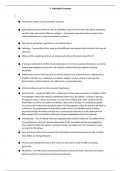
preview:● We have extravascular and intravascular haemolysis. ● Extravascular – maybe the RBCs have a deformity in their shape and what can happen is that macrophages within the reticular endothelial system (e.g. the spleen), as blood is passing through the spleen, realise that those red cells aren’t looking quite right, so they will take those RBCs out of the circulation and break it down into a number of constituents (globin into amin acids, release the iron from within the haemoglobi...
- Package deal
- Class notes
- • 12 pages's •
-
Aston University, Birmingham•clinical sciences
-
clinical sciences BM5CLS• Bysarah21jan
Preview 2 out of 12 pages
preview:● We have extravascular and intravascular haemolysis. ● Extravascular – maybe the RBCs have a deformity in their shape and what can happen is that macrophages within the reticular endothelial system (e.g. the spleen), as blood is passing through the spleen, realise that those red cells aren’t looking quite right, so they will take those RBCs out of the circulation and break it down into a number of constituents (globin into amin acids, release the iron from within the haemoglobi...
